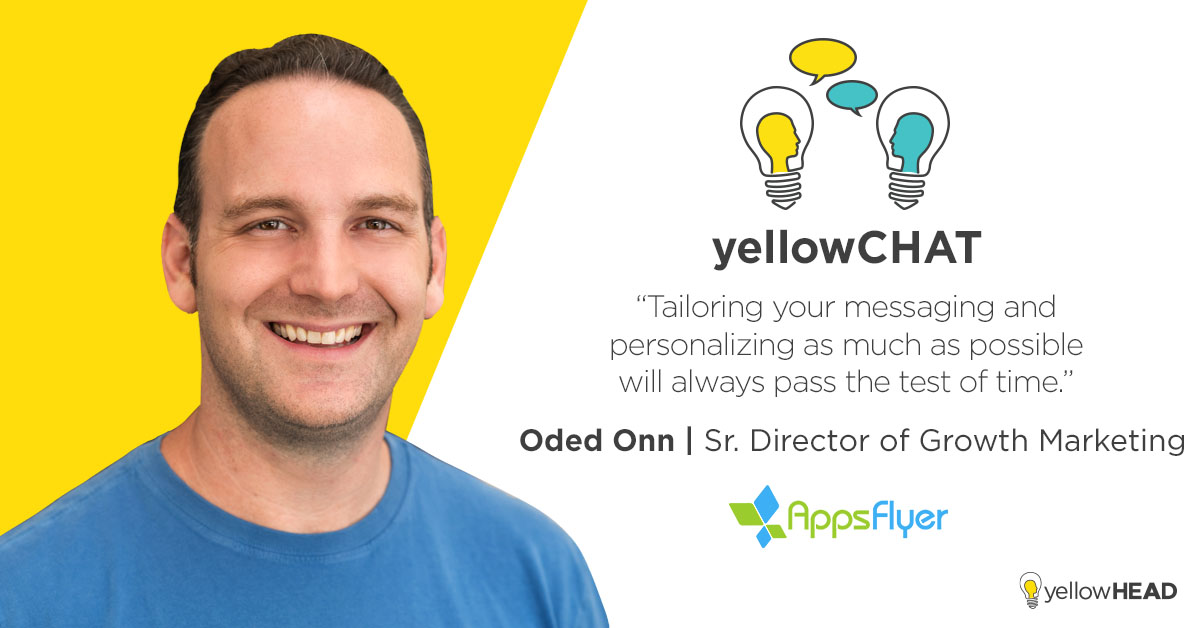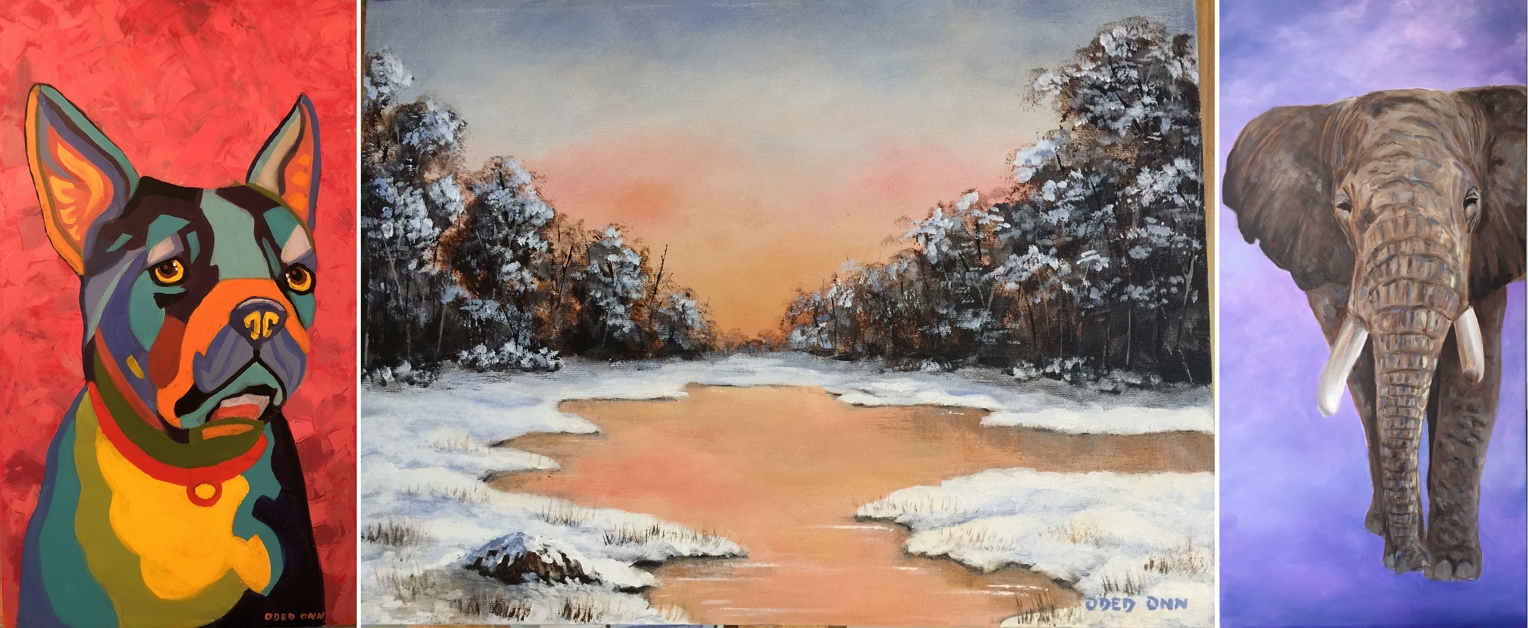Oded Onn Paints a Pretty Picture for Growth Marketing Strategies
Being the current Senior Director of Growth Marketing at AppsFlyer and former VP of Performance Marketing at Gett, we think it’s safe to say that Oded Onn knows a thing or two about how to market to consumers and businesses.
While studying at Tel Aviv University, Oded focused on History & Computer Science, and after working as a software engineer for nearly a decade at different startups, he pursued his MBA with a focus on Marketing and Consulting. Following graduation, he began working in Management Consulting in the US. He worked with a wide array of industries such as pharma, hospitals, tech, automotive, finance, banking, and more. These two fields gave him a pretty good taste of business and software.
Yet, he was always interested in marketing.
Back in Israel, performance marketing crossed his path, and Oded was intrigued due to its quantitative capacity and the ability to be very analytical within the marketing field.
While he was considering going into marketing or the product side of things, a friend reached out and said, “Hey, I’m looking for someone to run my user acquisition.” Oded joined the gaming company and made his way to become VP of Marketing & Monetization. It was here that he learned a lot about web publishing, app publishing, UA, and performance marketing.
From there, Oded made his way to Gett, and eventually over to AppsFlyer, the global leader in app attribution and mobile analytics. He now oversees all growth activities from content marketing to organic growth (SEO, CRO, and Web optimization), and all paid demand generation activities. He is also in charge of marketing operations, which is “basically the handshake between the Marketing organization and Sales,” and anything that has to do with marketing automation. Finally, providing all the localization and marketing analytics across the Marketing organization and beyond falls under Oded’s domain as well.
What growth strategies do you feel have passed the test of time throughout your career and across the different verticals you’ve worked in? Which new strategies do you see trending now?
Personalized Messaging
It is important to understand where your customers are coming from and at what stage. Finding out what their mindset is and matching your messaging and creatives accordingly will always work for growth.
Tailoring your messaging and personalizing as much as possible will always pass the test of time. Having said that, it’s definitely more of a trend for B2B to do more personalization and account-based marketing (ABM) – understanding and updating messaging based on the type of company and the type of account.
From a B2C perspective, if you do a cross-sale, cross-marketing, or retargeting, then you should understand what type of labels/titles people are interested in and tailor that to them. In general, personalization and matching the messaging to where users are in their journeys is easier for B2C compared to B2B, as user-journeys are much shorter.
Players in the industry analyze how users convert, and, based on a large enough sample, they can understand what would appeal to them more. They could identify elements such as users’ gender, preferred language or characters within the ad, and optimize ads as needed.
There are endless options for active segmentation, targeting, and personalization and, the better you get at it, the better your marketing efforts will be.
Automation and Creative Optimization
I think another trend is definitely all the automation and AI-based user acquisition.
If you think of B2C, this refers to anything from Google App Campaigns to campaign auto-optimization and campaign management tools. I believe that the role of a UA manager for B2C will really transform in the coming years.
It’s also important to understand more about creative optimization. What’s the messaging and how can we attract more users with the combination of copy and graphic assets?
Creative analysis and insights are also one of the trends you will see in terms of what machine learning can do to tag your creatives and offers. We already see some players in the market that are able to do so. Some tools can scan, map and analyze your creatives to understand how different themes, color palettes, and elements’ locations take part in the asset. Such tools can indicate which combinations would work best and use machine learning algorithms to recommend the user new assets to match based on audience segmentation and such. (similarly to Google’s UAC). You can then look at A/B testing more manually. For example, you will want to move your CTA or your button to the top, bottom, right, left, and so on.
But, I think we will see more and more auto generators, where creatives are actually being created by a machine and placed with a lot of different combinations in order to learn over time what works best for your specific title, target audience, etc.
Interesting that you mention that – it’s very similar to what we’re doing with Alison, tagging specific creative elements and making recommendations based on results. Seems like we’re all headed in the direction of automation.
Yeah, it’s about closing the circle. When you’re running campaigns, you want to understand both the cost side and the performance side. On the cost side, you aggregate all your costs up to the campaign, on the creative or keyword level (depending on if it’s Search or if it’s graphics). Then on the other end of it, you connect your revenue and performance – the click to the conversion to install to purchase. Basically, what we do at AppsFlyer – where we enable marketers to analyze and understand the ROI on their UA budget.
If you marry those two data sets (the cost & performance), you can really understand how your creatives generate revenue and performance. You can even learn how much your creatives cost, and what the effective cost per whatever-action-you-care-for is.
I definitely think this is where we are heading. And when you add that layer of insights to your creatives, analyze and optimize, you are guaranteed to generate good stuff.
What are some things that surprised you along the way in your Growth Marketing techniques?
I think most marketers can and probably should develop their technical and analytical skills even further. It’s very important that people keep pushing and developing in that respect. It gives you a lot of power to do your job well. I would say everybody should be sort of an analyst.
Even if you’re a graphic designer, there’s so much value in reading and understanding the numbers, how they operate and how you can look at them. It has surprised me to see that sometimes it’s not so prevalent.
This relates to growth marketing techniques because a lot of it used to be guesswork. I think part of it is still nowadays in many companies. It’s not perfect. Folks don’t really have the right numbers and the right data to make every decision, and by becoming more comfortable with the quantitative parts of the role, they can make better educated decisions.
Having worked with both B2B and B2C funnels, how do you adjust your marketing approach for each one?
I’d say that the major difference is the sales cycle, but it really depends on the type of business.
B2B can be a totally different sales cycle. It can easily be anywhere from a month to a year and a half because the decision-making unit is made of multiple people. You are not marketing to just one person.
In that cycle, there can easily be a hundred and fifty touchpoints. Five different people across a year and a half. You have to build way more awareness and education, then move them to consider your solution and only then move further down the proof of concept.
Versus a B2C funnel.
In the B2C funnel, where you meet the decision-maker in the ad stage, they can, most likely, convert immediately or within very few touchpoints. They’re just so much faster, so much easier to measure and attribute as opposed to B2B.
In B2B, you should change your marketing approach. You have to be way more involved and way more comfortable with not knowing exactly which touchpoint converted or assisted in each conversion because of the complexity behind it.
What are some of the challenges that the app attribution field (or AppsFlyer in particular) currently faces?
I think it’s actually an industry that is booming. It’s really in a very good place.
One of the challenges is false claims from some players in the industry of things they can’t actually do. It can be frustrating for AppsFlyer, but whatever. That’s competition.
I think the biggest challenge for the whole industry, in a sense, is the market. There’s a lack of knowledge about app attribution. You have a few hundred app developers and marketers that are savvier and understand why they need it, and how to fully utilize app attribution solutions, but the vast majority of the market is just not fully there yet.
The industry’s main challenge is education because it’s relevant for so many marketers, and, if you are looking at the overall universal attribution, there’s way more room to grow.
On a personal note, when you’re not driving growth for AppsFlyer, what are your passions?
Other than my family, my wife, and three sweet kids? My passions are actually art and traveling.
I do a lot of drawing and oil painting.
I also had a goal to go to 40 different countries by the age of 40, and did that, so, now I’ll aim for 50 before 45.
That’s a lot of countries. What are some of the more interesting places that you’ve been to?
So many great places, and each with its own unique nature and people. I’d say in terms of nature, Fiji, New Zealand, the Canadian Rockies, and Slovenia were amazing. In terms of cultural experiences, Nicaragua, Guatemala, Laos, China, and Nepal were my favorites. But honestly, after these Coronavirus times, I’d go anywhere in a heartbeat.
What advice would you give someone who is just entering the mobile marketing field?
Be really connected. Reading the main leading blogs is really, really crucial. It depends on what you do of course, but you should read on marketing in Medium, follow Incipia for ASO, Eric Seufert’s Mobile Dev Memo, etc.
The other thing is to be really involved in the community as well – have roundtables with other folks, go to meetups, go to conferences. Basically, it’s about getting to know other people and talking to people that are in a similar position in order to learn from their challenges and how they tackle them.
Some of my best learnings were from other friends in the industry that I meet on a regular basis, and I think it’s a great tool. This is right for almost any industry, but I still think it’s really important.
What is your golden tip?
I would say really understand your funnel. Understand your conversion, incrementality, and what levers you can pull to change.
Focus on the 80:20. Consider the things that you can change that will have a major impact. Don’t sweat the small stuff, because people optimize for a lot of small things that don’t matter. Whereas, if they really focus on the 1-2 major factors, oftentimes the impact will be so much higher.



